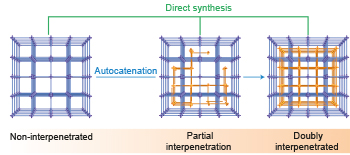Nature Chemistry ( IF 19.2 ) Pub Date : 2016-01-25 , DOI: 10.1038/nchem.2430 Alan Ferguson , Lujia Liu , Stefanus J. Tapperwijn , David Perl , François-Xavier Coudert , Stijn Van Cleuvenbergen , Thierry Verbiest , Monique A. van der Veen , Shane G. Telfer

|
Interpenetration, the entwining of multiple lattices, is a common phenomenon in metal–organic frameworks (MOFs). Typically, in interpenetrated MOFs the sub-lattices are fully occupied. Here we report a family of MOFs in which one sub-lattice is fully occupied and the occupancy level of the other can be controlled during synthesis to produce frameworks with variable levels of partial interpenetration. We also report an ‘autocatenation’ process, a transformation of non-interpenetrated lattices into doubly interpenetrated frameworks via progressively higher degrees of interpenetration that involves no external reagents. Autocatenation maintains crystallinity and can be triggered either thermally or by shear forces. The ligand used to construct these MOFs is chiral, and both racemic and enantiopure partially interpenetrated frameworks can be accessed. X-ray diffraction, nonlinear optical microscopy and theoretical calculations offer insights into the structures and dynamic behaviour of these materials and the growth mechanisms of interpenetrated MOFs.
中文翻译:

金属有机框架中的受控部分互穿
互穿是多个晶格的缠绕,是金属有机框架(MOF)中的常见现象。通常,在互穿的MOF中,子晶格被完全占用。在这里,我们报告了一个MOF系列,其中一个子晶格被完全占据,而另一个子晶的占有水平可以在合成过程中得到控制,以产生具有可变部分互穿水平的框架。我们还报告了一个“自动分类”过程,即通过不涉及外部试剂的互穿程度逐渐提高,将非互穿晶格转换为双互穿框架。自动分类可保持结晶度,并且可以通过热力或剪切力触发。用于构建这些MOF的配体是手性的,外消旋和对映体部分互穿的骨架均可使用。















































 京公网安备 11010802027423号
京公网安备 11010802027423号